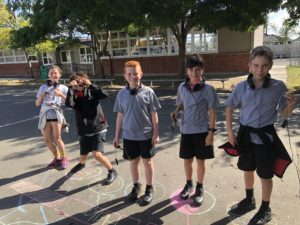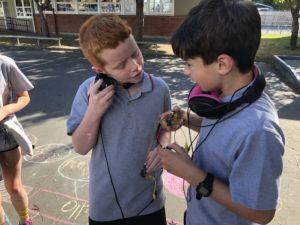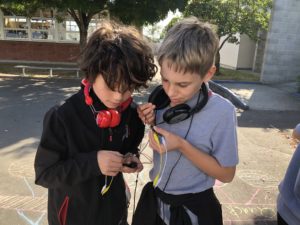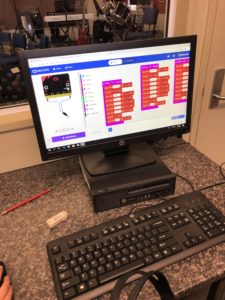Micro:bit project ideas with music learning
Either headphones or a speaker will need to be connected to the micro:bit for these projects on micro:bits, or they can be run in the browser.
1. Play a note (and sort)
Code the Micr:bit to play a note between middle C and high C when button A is pressed (or shaken etc). 6 students connect their micro:bits to speakers (headphone hack, but not to be worn) and use them in the sorting network.
2.Pass the note
In small groups, each student uses this code, but choses their own “my note” value from the array (C, D, E G, A).
Once loaded they stand in a group and player one plays their note (button A) then presses A+B to produce a random 2nd note from the list. The player who has that note, catches it by playing their A button to check it’s the same, then presses A+B to release a new random note belonging to the next player!
Note we first tried this using shake to get the random note (like shaking a dice) but a number of batteries connections were lost in the process, so it may be safer to use a button choice as in the example!
https://makecode.microbit.org/_fKy1pmcCPAqV
3. Interval training
https://makecode.microbit.org/_WkuL9tL5K3CK
or https://makecode.microbit.org/_AEKHUb2MXUMU
At this stage it is just a random interval generator and can’t give feedback on answers.
4. Twinkle Twinkle Micro:Star
https://makecode.microbit.org/_P5pAtcWLeh5w (link to a project demo)
This project is designed to be worked in pairs.
- Code the three phrases of Twinkle Twinkle Little Star sot hat they play on a trigger (eg. Button, A, A+B, B, shake?)
- Once loaded onto the micro:bit and tested, give it to your partner who should try to perform the whole of the song by working out which phrase is triggered and performing in order.
- Create a visual for each phrase (The example has the letter names showing as the notes are played, but any visual could be chosen so long as the student can explain why it’s chosen)
5. Spot the difference: melodic phrases
Which phrase is different? A, B or A+B?
6. Micro:bit Scales and arpeggios for music theory class
Program the micro:bit so that button A or B plays a major scale or arpeggio (or short melody), and button B or A plays a minor scale or arpeggio (or short melody). (LEDs are not needed, but if students choose to use them, what related image might the LEDs show without giving the answer away? The note names?)
Give to a partner to see if they can tell what the buttons do by listening.
Variation: Programme ascending and a descending scales with different triggers….
7. Micro:composition
Students compose different short ‘character’ motives triggered by shakes or buttons.
- A happy character musical theme
- A sad character musical theme
- A villain musical theme
8. Micro:Ear-training
Students programme the three triggers (A, B and A+B) with two different audio events – two the same and one slightly different. Their partner plays all three triggers and names which one is different and how it is different.
It could be two 5 note melodies, with one note different in one of the triggers. Is the “different note” higher or lower?
It could be two different but similar short rhythms. Which beat has the different rhythm?
9. Micro:Metronome
Students make a metronome. Use buttons to change tempo up or down..
Also try a metronome version where you can tap a beat on the mocro:bit to find the tempo.
10. Make an instrument.
Use a variety of inputs or trigger by movement to make instruments such as a “keyboard”, theremin… or guitar as seen here: https://makecode.microbit.org/projects/guitar





